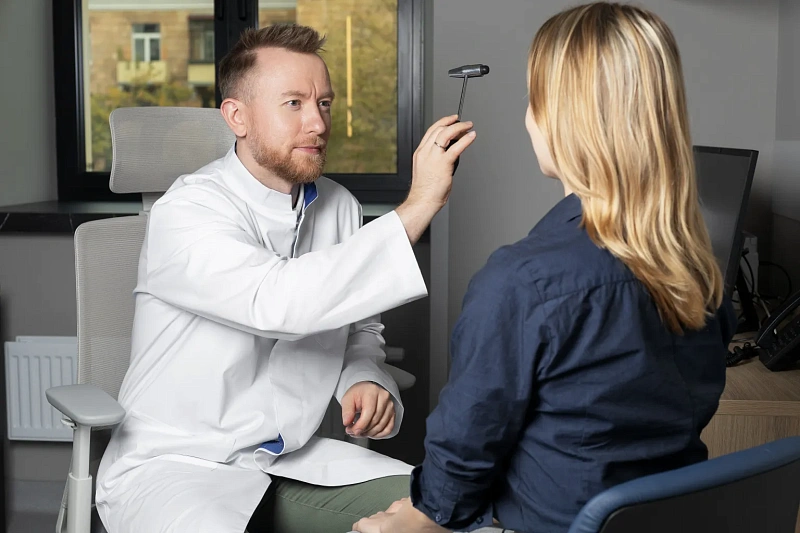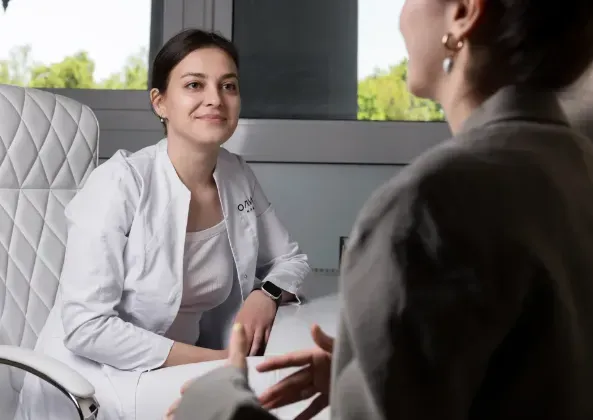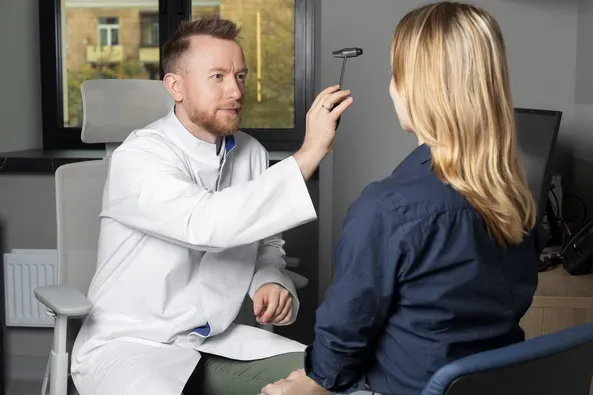Neurologist's appointment
Specialists diagnose neurological symptoms. Among the disorders of NS, it is customary to distinguish several groups of clinical signs — pain syndrome, motor and/or sensory disorders, coordination disorders, pelvic disorders and general symptoms.

Neurology deals with the study of the central nervous system (CNS), including the brain and/or spinal cord, as well as the peripheral nervous system (PNS), which includes spinal roots, peripheral nerves and their plexuses, neuromuscular synapses.
Neurological diseases can cause pain, decreased sensitivity, impaired coordination of movements, and other symptoms. Consultation with a neurologist is necessary to accurately determine the cause of the disease and select effective treatment. At the consultation, the neurologist conducts a survey of the patient, followed by a neurological examination. If necessary, additional examinations such as magnetic resonance imaging (MRI), computed tomography (CT), electroencephalography (EEG) and laboratory tests can be prescribed.
At the initial examination, the neurologist conducts a survey of the patient, clarifies complaints, previous diagnoses and methods of treatment. Studies the medical history, data from previous examinations and appointments, and is interested in how long the symptoms have been bothering. Proper diagnosis is very important for choosing treatment tactics. Then the doctor examines the patient. A neurologist conducts a series of tests to evaluate the work of reflexes on the skin, in the pupils, and limbs. The neurologist pays attention to posture, motor activity, coordination of movements, tremor of the arms and legs, the presence of tics. Specific samples and testing make it possible to assess the condition of the central nervous system and PNS. Also, during the appointment, the neurologist gives a referral for laboratory tests and instrumental diagnostics.
To consult a neurologist, we use: Tools for conducting a neurological examination. Computed tomography (CT) and magnetic resonance imaging (MRI) to visualize the brain and spinal cord. Electroencephalograph (EEG) for recording the electrical activity of the brain.
Before consulting a neurologist, it is important to prepare the results of previous studies and analyses in advance, including MRI or CT scans (possibly on electronic media). Make a list of medications and supplements you take, as well as describe the symptoms, indicating their duration and possible factors influencing their manifestation. Alcohol and drugs that affect the nervous system should be avoided the day before the visit, unless they have been prescribed by a doctor.
Benefits
Modern medical equipment
It allows the detection of neurological diseases in the early stages and with high accuracy.
Personalized treatment
An approach focused on the characteristics of each patient.
An integrated approach
Using a variety of diagnostic methods to accurately identify the problem.
Psychological support
Assistance in adapting to diagnosis and managing neurological conditions.
Preparation
Before consulting a neurologist, it is important to prepare the results of previous studies and analyses in advance, including MRI or CT scans (possibly on electronic media). Make a list of medications and supplements you take, as well as describe the symptoms, indicating their duration and possible factors influencing their manifestation. Alcohol and drugs that affect the nervous system should be avoided the day before the visit, unless they have been prescribed by a doctor.

Consultation
The consultation begins with a medical history and general examination, including checking pupil, skin and other reflexes, coordination, gait, sensitivity and muscle strength. The doctor can use neurological tests and tests to identify possible lesions of the nervous system. A neurologist can refer a patient for MRI, EEG or ultrasound of the spine, head and neck vessels to assess the functions of the brain and nervous system. According to the results of the diagnosis, the doctor makes a diagnosis and prescribes treatment.

Specialists
Find a SpecialistIndications and contraindications
Indications
Chronic pain
For example, migraines or chronic back pain.
Traffic violations
Such as tremor, gait instability.
Sensory disturbances
Loss of sensitivity or paresthesia.
Cognitive changes
Memory loss, decreased concentration, behavior change.
Expected effect
Treatment of pain syndromes
Pain reduction and improvement of the patient's functional state.
Accurate diagnosis
A thorough study of clinical cases of any complexity.
Prevention of complications
Preventing the progression of the disease or the development of new symptoms.
Comprehensive disease management
Effective management of neurological diseases.
Similar referral activities
Headache Treatment
An individual approach to the treatment of headaches, aimed at eliminating symptoms and identifying the root cause.
Migraine Treatment
Treatment aimed at reducing the frequency and intensity of migraine attacks. It may include drug therapy, behavioral and cognitive techniques, as well as recommendations for lifestyle and nutrition changes.
How to reach
How to get
From the Belorusskaya metro station of the Zamoskvoretskaya line - exit 4 After exiting the subway, walk through the pedestrian tunnel and climb the stairs. Move towards the railway tracks, go down the stairs immediately after them and walk along the house, then turn right onto 1st Yamskoye Pole Street. At the turn to 3rd Yamsky Pole Street, cross the road at the pedestrian crossing and continue along 1st Yamsky Field Street, after a few buildings on the left you will see Olympus Clinic MARS.
Travel time
9 minutes
Landmark
Olympus Clinic MARS sign
How to get
From the Belorusskaya metro station of the Ring line - exit 2. After exiting the subway, turn left and walk to the pedestrian crossing. Cross the road through two pedestrian crossings and move along the Tverskoy overpass. Go down the stairs immediately after the railway tracks, walk along the house, then turn right onto 1st Yamskoye Pole Street. At the turn to 3rd Yamsky Pole Street, cross the road at the pedestrian crossing and continue along 1st Yamsky Field Street, after a few buildings on the left you will see Olympus Clinic MARS
Travel time
11 minutes
Landmark
Olympus Clinic MARS sign
From the metro station "Tsvetnoy Bulvar"
1 exit to the city, then left to the Garden Ring, at the crossing to the right, crossing the boulevard, one more crossing and at the traffic light to the left. The Olymp Clinic building is located overlooking the Garden Ring to the right of the crossing. Travel time is approximately 9 minutes. Landmark - sign Olymp Clini
From the metro station "Sukharevskaya"
Exit 3 from the metro and 640 meters straight ahead, the clinic will be on the right. Landmark - sign Olymp Clinic
Parking lot map
Exit 3 from the metro and 640 meters straight ahead, the clinic will be on the right. Landmark - sign Olymp Clinic

From Sokol metro station
The last car from the center: follow the signs for Exit 5. From the glass doors to the right and go to the end of the passage. Exit to the city by the steps to the left. After exiting the crossing to the street, go straight along Leningradsky Prospekt to the intersection with Chapaevsky Lane. Next, turn right (onto Chapaevsky Lane) and walk to the Triumph Palace residential complex. Entrance to the territory: through checkpoint No. 1, opposite the Vkusville store, you will need to present your passport. After passing through the checkpoint, go up the stairs to the fountain, opposite it you will see our clinic.
Travel time
10-12 minutes
From the Airport metro station
The first car from the center: follow the Exit 2-3 signs. Turn left out of the glass doors and walk to the end of the passage. After exiting the crossing to the street, go straight along Leningradsky Prospekt to the intersection with Chapaevsky Lane. Next, turn left (onto Chapaevsky Lane) and walk to the Triumph Palace residential complex. Entrance to the territory: through checkpoint No. 1, opposite the Vkusville store, you will need to present your passport. After passing through the checkpoint, go up the stairs to the fountain, opposite it you will see our clinic.
Travel time
12-15 minutes
How to get
Entry to the territory is prohibited, but there are free city parking lots around the Triumph Palace residential complex, where you can easily find a place for your car. Free parking area:



